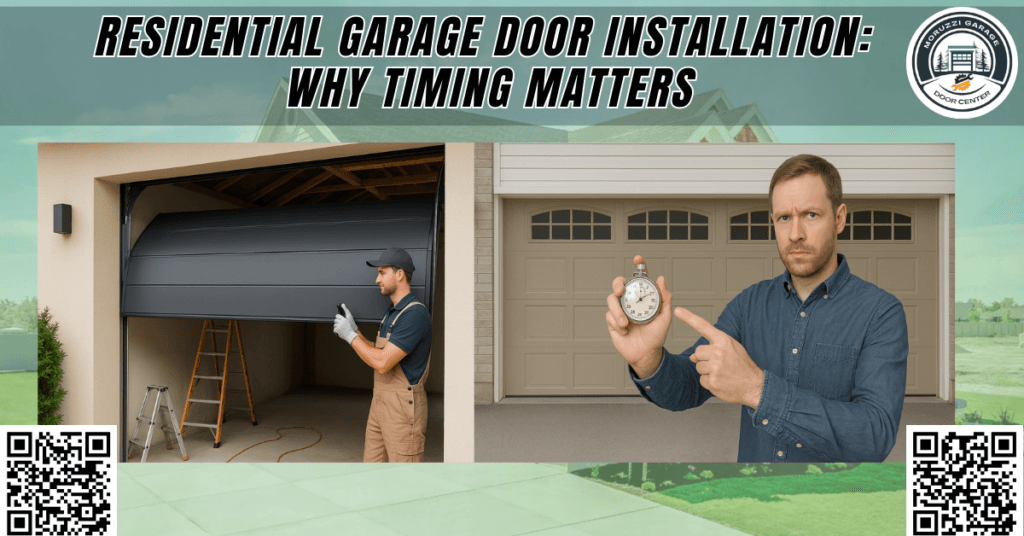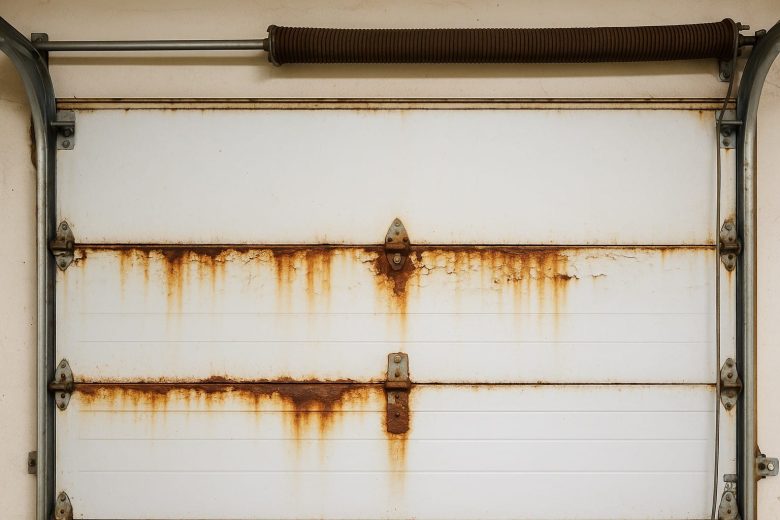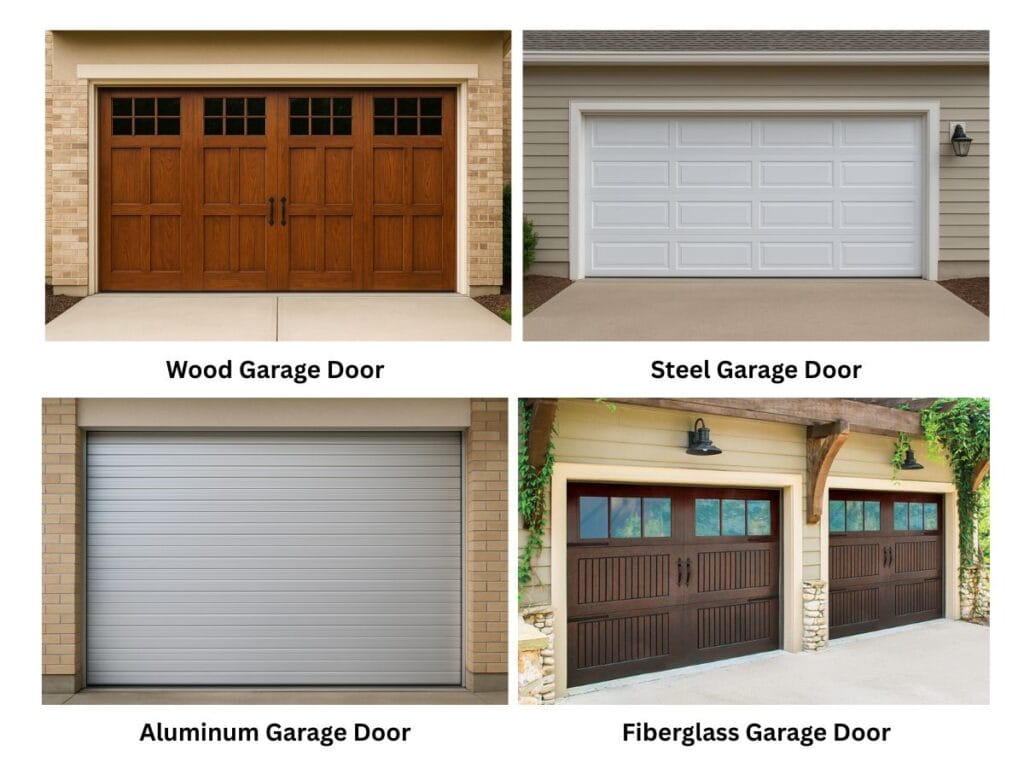Residential Garage Door Installation: Why Timing Matters

By Moruzzi Garage Door Center – Philadelphia, PA
Philadelphia homeowner Susan called us in a panic one January morning. Her garage door wouldn’t budge, and her car was stuck inside. The culprit? A worn-out torsion spring finally snapped after months of delay. She had been putting off a new residential garage door installation, not realizing how critical the timing truly was. At Moruzzi Garage Door Center, we’ve seen this story repeat too often. Whether it’s a broken spring, worn brackets, or a warped panel, delaying an installation can create costly problems and unsafe conditions.
According to a recent survey by the International Door Association, over 60% of residential garage doors in urban areas like Philadelphia are overdue for replacement or have not received proper maintenance in the past 3 years. That’s a lot of risk riding on your garage door system. Your garage door isn’t just a piece of your home’s exterior, it’s a central part of your daily routine and a key element of your home’s energy performance and security.
In this guide, we’ll take a deep dive into why timing matters for your garage door installation, the best time of year to tackle this upgrade, and how a step-by-step guide can lead to a smooth, safe, and cost-effective process. Whether you’re replacing an old door or installing one on a new home, knowing when and how to act can make all the difference.
Why Timing Is So Important for Residential Garage Door Installation
A garage door is a large, complex mechanical system made up of dozens of components—springs, brackets, panels, rollers, tracks, hinges, drums, and more, all of which must work together for smooth and safe operation. Installing a new residential garage door at the right time helps prevent a cascade of failures that could compromise safety and increase costs.
1. Safety Is Non-Negotiable
Garage doors can weigh 150 to over 300 pounds, depending on their size and materials. If a torsion spring or cable breaks unexpectedly, the entire door system could collapse, endangering people or pets nearby. Waiting too long to replace your garage door increases the chance of component failure and unsafe conditions. A new installation, completed at the right time, ensures proper operation, with parts like the center bracket, flag brackets, vertical tracks, and safety sensors working in harmony to protect your family.
2. Efficiency and Energy Costs
Your garage door panels, particularly insulated ones with a high R-value, help maintain the temperature of your garage. Poor insulation or gaps in the bottom panel or brackets can lead to heat loss during the winter and increased energy consumption in the summer. An on-time garage door installation with insulated panels and quality weatherstripping can lower your heating and cooling bills and increase your home’s overall energy efficiency.
3. Emergency Repairs Are More Expensive
When your old garage door opener dies suddenly or the door goes off the tracks, you may be forced into emergency service calls. These often come with premium charges and limited style or parts availability. Timely installation lets you choose your preferred garage door style, color, insulation level, and features without the pressure of a crisis. Plus, it gives you a chance to plan for upgrades like smart openers or new garage door sections.
Best Time of Year to Install a Garage Door in Philadelphia
Philadelphia’s weather can wreak havoc on older garage doors from snow and ice that freeze torsion springs, to summer humidity that warps wooden panels. That’s why choosing the right season for garage door installation is critical.
Spring and Fall: The Prime Seasons
These mild-weather seasons are ideal for garage door installation because they provide the best working conditions. Temperatures are moderate, allowing garage door professionals to install the door without weather delays. Materials like insulation, torsion tubes, and brackets perform best at moderate temperatures, ensuring proper calibration and alignment during the installation process.
Summer: High Demand, Longer Waits
Summer is a popular season for home improvement, which means professional installation services are in high demand. If you choose this time, book your installation early. Delays are common, and the hot weather can affect how torsion springs are tensioned, impacting smooth operation if not installed correctly.
Winter: Risky and Delayed
Cold temperatures can make metal parts brittle, reduce flexibility in insulation, and lead to icy or unsafe garage openings. While installation is possible, it’s slower and prone to weather-related interruptions. Snow-covered driveways and freezing rain can delay or damage components like track assemblies, hinges, and flag brackets.
How to Know It’s Time to Replace Your Garage Door
Delaying your residential garage door installation puts your home at risk. Watch for these warning signs that it’s time to act:
- Visible Rust or Deterioration on your brackets, panels, or torsion springs
- Noisy Operation: grinding, banging, or screeching from worn rollers or tracks
- Sagging Door Sections or misaligned garage door panels
- Slow or Jerky Movement, a sign of failing garage door openers or unbalanced springs
- Repeated Repairs or the need to frequently replace small parts
- Outdated or Unsafe Design with no safety sensors or modern controls

If you notice one or more of these issues, call a professional garage door technician immediately for an inspection and recommendation.
Planning a Successful Garage Door Installation
Proper planning leads to a successful garage door installation. Here’s how to do it right:
1. Choose the Right Door for Your Home
From wood to steel, composite to aluminum, garage doors come in a range of materials, styles, and insulation levels. Decide on your priorities: Do you want enhanced curb appeal? Low maintenance? High insulation for energy savings?

2. Schedule a Professional Inspection
Before you remove the old door, have a technician inspect the garage opening, ceiling clearance, track placement, and existing opener system. They’ll determine whether you need new horizontal tracks, vertical tracks, or torsion hardware.
3. Prepare for Installation
Clear the garage space, remove vehicles, and ensure there’s no clutter near the tracks or wall brackets. Having access to necessary tools like vise grips, zinc hex lag bolts, and hinge brackets will make the process smoother, though this is typically handled by the pros.
Step-by-Step Guide to Residential Garage Door Installation
Here’s a general overview of what a professional installation looks like:
Step 1: Remove the Old Door
The team disconnects the garage door opener, removes the tension from the torsion springs, unbolts the brackets, and carefully lowers the old panels to avoid injury or damage.
Step 2: Install Bottom Panel and Track Assembly
The new bottom panel is placed, leveled, and connected to the vertical track and flag bracket. Hinges, brackets, and rollers are added to allow proper alignment.
Step 3: Stack Remaining Panels
Each panel is installed one at a time, with hinges, bolts, and brackets added between sections for strength and stability.
Step 4: Install the Torsion System
The torsion tube, cables, drums, and torsion springs are mounted above the door. These must be calibrated for proper spring tension to ensure the door opens smoothly and evenly.
Step 5: Attach the Opener
The garage door opener, whether chain, belt, or screw drive, is mounted to the ceiling and connected to the door system. Safety sensors are installed near the bottom panel to prevent accidents.
Step 6: Final Testing and Adjustment
The system is tested for smooth operation, balance, and safe operation. The technicians check the garage door opening, ensure proper bracket alignment, and fine-tune spring tension.
Cost Considerations and Long-Term Savings
The average garage door installation cost in Philadelphia ranges from $900 to $2,500, depending on the door’s size, materials, insulation, and whether a new garage door opener is also installed. Investing in a high-quality door with good insulation, durable torsion springs, and a reliable opener system pays off in:
- Lower energy bills
Fewer repairs over time - Increased home value
- Enhanced security and convenience
Why Professional Installation Is Essential
While DIY tutorials may exist, installing a garage door is not a one-person project. The high tension in torsion springs, heavy panels, and precise alignment required means that only trained professionals should handle the job.
Our team at Moruzzi Garage Door Center uses the right tools, follows manufacturer installation instructions, and ensures all parts, from springs to brackets to cables, are properly installed and adjusted. This guarantees not only a successful installation, but one that will last for years with routine maintenance.
How Can Moruzzi Garage Door Center Help You?
At Moruzzi Garage Door Center, we specialize in residential garage door installation that combines quality, safety, and style. Our trained technicians serve homeowners throughout Philadelphia and the surrounding areas with:
✅ Expert inspections and recommendations
✅ Custom and standard door options
✅ Professional installation of doors, openers, springs, and tracks
✅ Fast service with minimal disruption to your day
✅ Competitive pricing and clear communication
📍 Visit Us: 1300 Market St, Philadelphia, PA 19107
📞 Call Now: (267) 732-0907
Don’t wait for your garage door to fail. Whether you’re replacing an old door, upgrading for better insulation, or adding a smart garage door opener, we’re here to help every step of the way. Call us today to schedule your consultation and ensure your home is safe, stylish, and ready for the future.
Frequently Asked Questions (FAQs)
1. How long does it take to install a new residential garage door?
A standard residential garage door installation typically takes 3 to 6 hours, depending on the door type and whether the opener or hardware also needs replacement.
2. Do I need to be home during the garage door installation?
While it’s helpful to be available at the beginning and end of the installation, most professional installers can complete the job without your constant presence.
3. Can I reuse my existing garage door opener with a new door?
In many cases, yes, but it depends on the opener’s compatibility with the new door’s weight, height, and track system.
4. Will installing a new garage door affect my home insurance?
Some insurers may offer discounts for installing a modern garage door with enhanced safety features like automatic reversal systems and reinforced panels.
